What’s The Difference? 17 Types of Sparkling Water Taste-Tested
By Sarah Jampel
This summer, I asked Amanda Sims if she wanted something at the grocery store: “Pellegrino,” she specified: “Not Perrier.”
I found her predilection to be quirky until I realized that loyalty to sparkling water beverages runs deep.
Related: 3 Steps Anyone Can Take to Reduce Water Consumption
Samantha Weiss-Hills frequently brings in her own personal can of La Croix (unflavored or lime) from home — even though our office is equipped with a soda maker — while our intern Taylor Rondestvedt prefers Mendota Springs Sparkling Water, another Midwestern brand.
Related: A Magical Trick for Keeping the Sparkle in Your Sparkling Wine
And then my friend Rebecca sent me this photo of the refrigerator at her Chicago workplace:
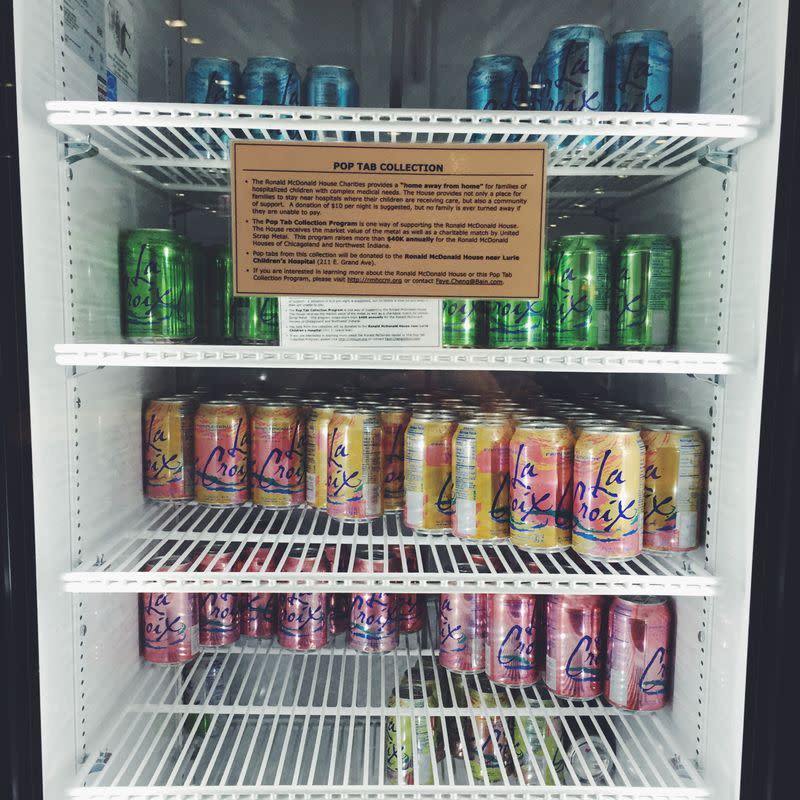
Woah. Photo: Rebecca Levinsky/Food52
But do these brand loyalties simply grow out of habit, or do they have a basis in truth (or at least in taste differences)?
To find out, we did a blind taste test of 17 seemingly similar products — seltzer, club soda, carbonated mineral water, and sparkling water — to see if we could tell the difference. (And to figure out if Sam could identify La Croix from the lineup.)
Related: 5 Variations on a Spritz
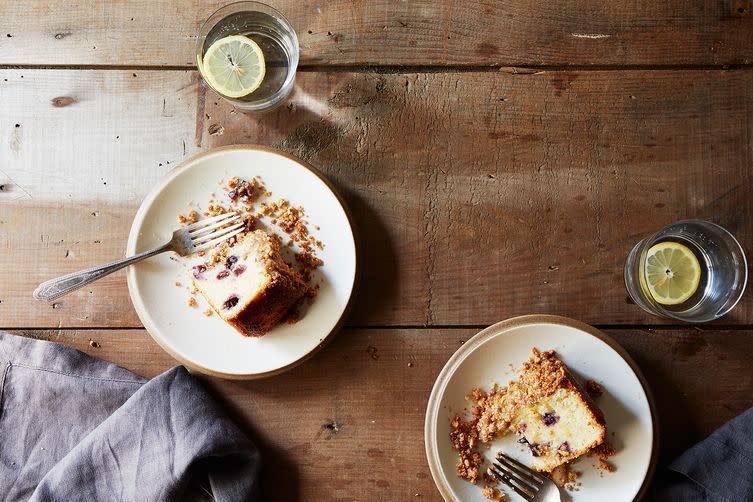
Sparkling water! With a side of blueberry cake. Photo: Bobbi Lin/Food52
Here’s what we concluded:
The individual products do taste and feel different, but it’s hard to tell the categories of beverages apart. (No one was able to identify group 1 as seltzer or group 2 as club soda, for example.)
And while the drinks do taste different, there was disagreement about how they tasted. One drink was simultaneously described as “tap water"and "flat Champagne"—and this discrepancy was true of every bottle or can. We found that most differences involved flavor (subtle, salty, citrusy) and the bubble experience (sharp tiny bubbles, large mellow bubbles, or aggressively tingling bubbles, for example). "The quality of the bubble is the thing,” concluded one taster.
No one successfully identified which bottles were most expensive. The European-ish, fancy glass bottles that I avoid at the grocery store were indiscernible from the canned generic kind. One editor pegged the Whole Foods-365 club soda—one of our most affordable choices—as “more expensive.”
Some waters pair better with food than others. Though we tried all of the sparkling beverages without food, we imagine that eating alongside sipping would alter the experience. Aggressive bubbles might help dissipate the heat of spicy foods but overpower other sensation; more delicate carbonation might be more appropriate for food with subtler flavors.
Temperature probably makes a difference. We tasted all drinks at room temperature, though we imagine that they would have been perceived as “more refreshing” had they been chilled.
Sam successfully identified La Croix (but Amanda did not correctly pick out Pellegrino).
Drinking this much sparkling water will make you really, really full (and burpy).
Related: 10 Buzzy Ways to Eat (and Drink) Your Beer
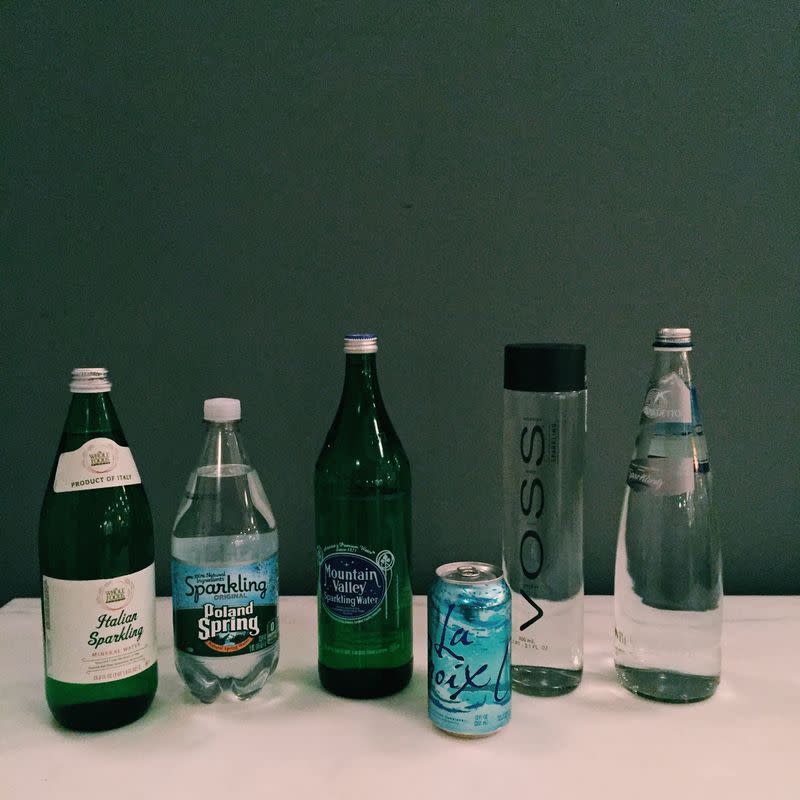
The 6 sparkling waters. Photo: Sarah Jampel/Food52
Sparkling Water
Sparkling water is a broad umbrella term that can be used to describe club soda, seltzer, or sparkling mineral water. Here were the five bottles that self-identified as “sparkling water” without a more specific demarcation.
Whole Foods Brand Italian Sparkling Water: This had a “very clean flavor” that our tasters predicted came from a glass bottle (they were right!). The flavor was neutral and “inoffensive,” while the bubbles were big and slow-acting.
Poland Spring: While some were put off by a “plasticky” taste, others detected (to borrow a word from wine) “minerality.” It’s like “sucking on a rock,” said Leslie Stephens.
Mountain Valley: The bubbles were deemed “perfect: soft but present.” Each bubble was said to be a distinct individual, popping identifiably on the tongue. This, too, had mineral notes — “but in a good way.”
La Croix: Samantha correctly identified her beloved sparkling water, which she calls “summer in a can.” The bubbles — smaller than most of the other drinks—act as if they’re on a “time release” or a “cascade,” starting off strong and fizzing out slowly on the tongue.
Voss: Tasters noted a subtle sweetness (“it has a taste of beginning”) and very little carbonation.
San Benedetto: “Tastes like tap water,” said one taster. The small bubbles were “so small, they’re prickly,” like Pop Rocks or needles.
Related: 11 Drinks to Start Your Morning
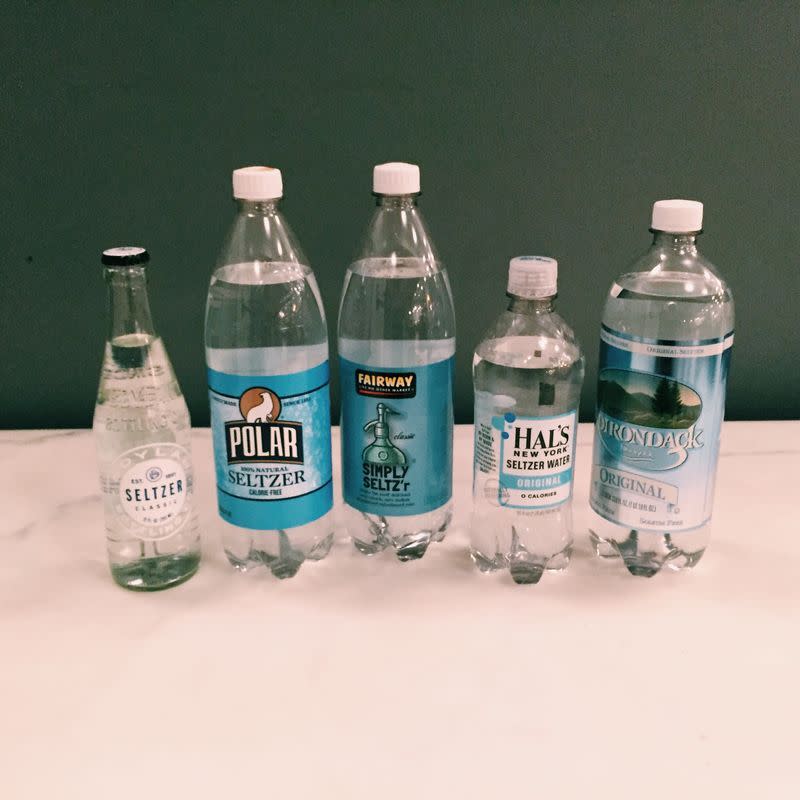
The 5 seltzers. Photo: Sarah Jampel/Food52
Seltzer
Seltzer is plain water that has been artificially carbonated with carbon dioxide, with no added ingredients (like salt or potassium salts).
Boylan: With many more bubbles than the others in its group, it was described by one editor as “slap-to-the-face aggressive”; another said it was “almost foamy.”
Polar: It had large, mellow bubbles and a strong “water” taste, though we did notice a citrusy, lime-y flavor upon first sip.
Fairway Brand: The bubbles are quick, imparting a pinpoint sensation: One editor explained the sensation as “ping-ping-ping, very fast.” The texture was foamy and light, and although there were no added ingredients, some said it had a slightly lemony (and/or slightly metallic) flavor.
Hal’s: “This is like cake,” said one taster. Almost sweet and easy to drink, with fewer and tinier bubbles, this beverage is hereby dubbed “cake water.”
Adirondack: The flattest of the five, it was compared both to tap water and to flat Champagne. The bubbles are floaters, traveling swiftly to the back of the throat, where they make themselves known.
Related: The After-Dinner Drinks Made for the Holidays: Digestifs
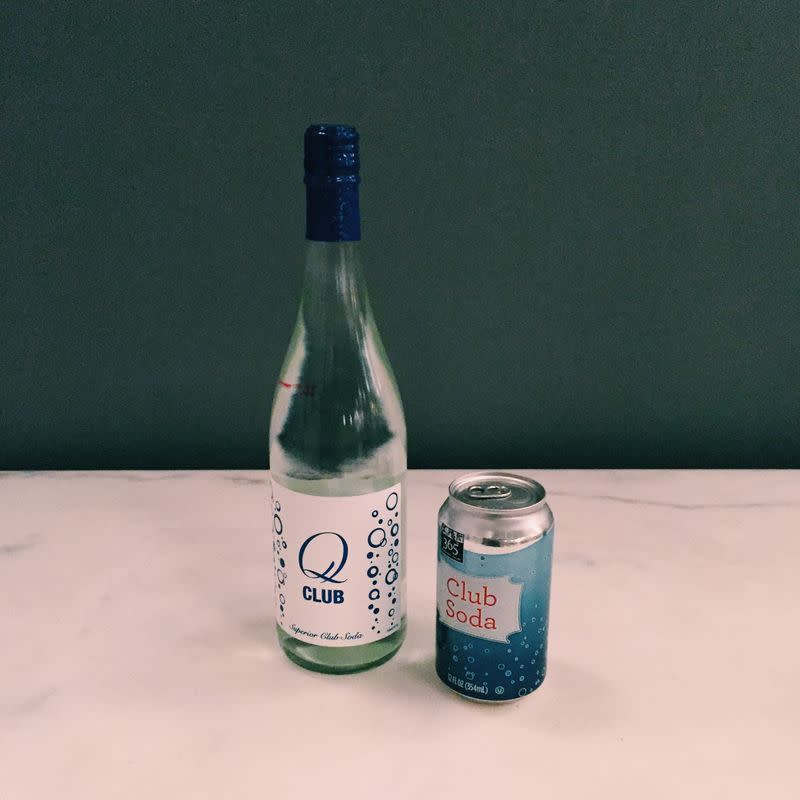
The 2 club sodas. Photo: Sarah Jampel/Food52
Club Soda
Club soda is seltzer’s bulked up brother: It’s got sodium salts and/or potassium salts, which can include table salt and baking soda. These are added to neutralize acidity and imitate the flavors of natural water.
Whole Foods 365 Brand: While some of us found the bubbles to be almost too harsh (causing a tingling sensation from the lips inwards), others predicted it was one of the most expensive of our tasting. Another person thought it “could be Perrier.”
Q-Club (Superior Club Soda): Surprisingly, this was also identified as Perrier. It had a distinctly citrusy, “lime-forward taste"— the editors couldn’t believe it wasn’t flavored. (Q-Club, according to its website, is made with Himalayan salt.)
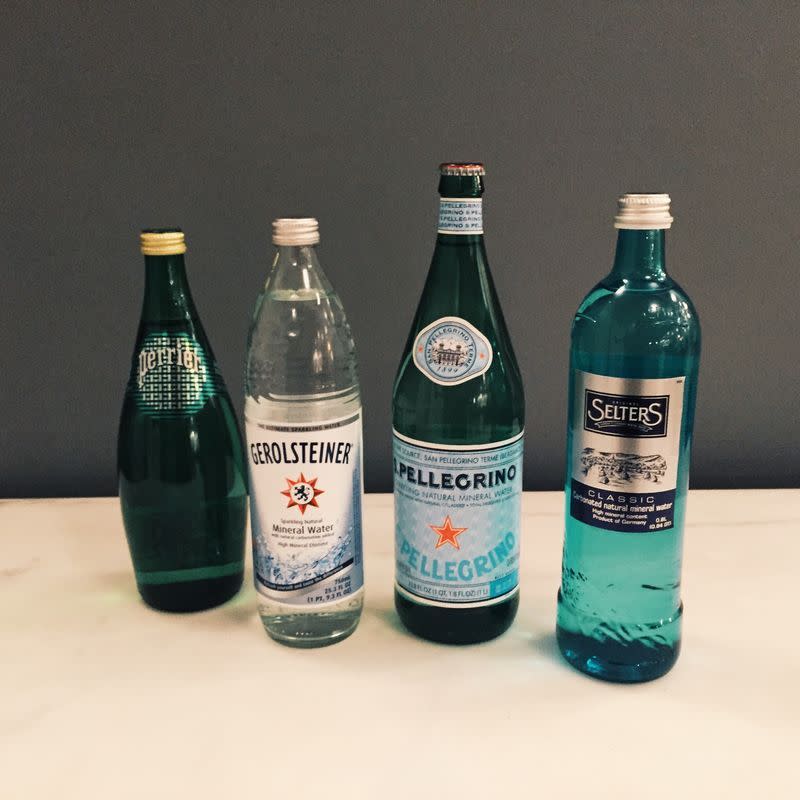
The 4 carbonated mineral waters. Photo: Sarah Jampel/Food52
Carbonated Mineral Water
Mineral water is defined as sparkling water that comes from a mineral spring. According to the The Food and Drug Administration, it must contain "no less than 250 ppm total dissolved solids that originates from a geologically and physically protected underground water source.”
Neither minerals nor carbonation is added (with the exception of San Pellegrino; according to the Huffington Post, additional carbonation is added to Pellegrino by the bottler). "Spring water,” on the other hand (see Mountain Valley Spring Water above), comes from a natural source but contains less than 250 parts per million dissolved minerals.
Perrier: Tasters were surprised by the tiny bubbles, so small that some people found it felt “almost flat.” The little bubbles moved in all sorts of directions, like electrons, and Amanda Sims—the one who had specified I not buy Perrier—said, and I quote, “I like it.”
Gerolsteiner: Described as simultaneously foamy and flat, Gerolsteiner also had an unusual taste: “Is that wet wood?” asked Ali Slagle. Others identified notes of rainwater.
San Pellegrino: The bubbles, tasters noted, were weak: “not flat but not trying hard enough”, “a man in a tutu starting to leap.” Leslie Stephens declared she was uninterested. No one identified this famous, fancy drink (not even its fan Amanda Sims).
Selters: “That’s Pellegrino,” Taylor Rondestvedt said decisively.
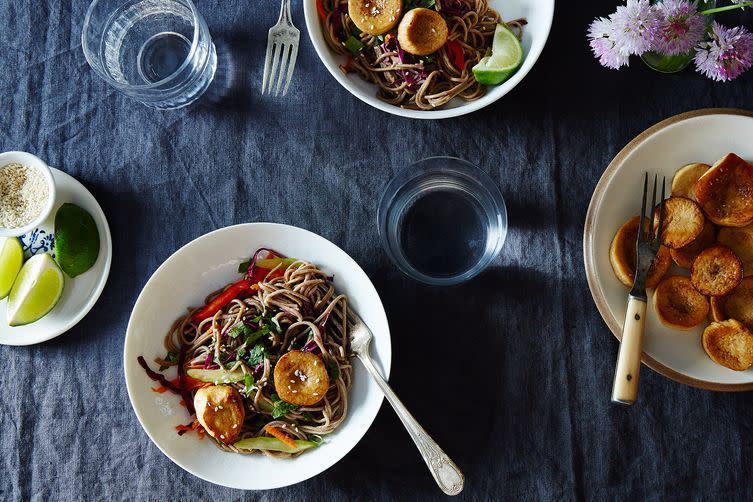
Water! and some sesame noodles. Photo: James Ransom/Food52
And so, a fitting conclusion to our very inconclusive sparkling water test. People cling to a certain type of sparkling water — they’re used to it, they actually like it, or they haven’t tried many others. And there are other factors, like temperature, what you’re eating it with, how many sparkling waters you’re trying at once, that alter the experience.
Basically, we’re not becoming water sommeliers anytime soon.
Thirsty for more water? Check out these stories:
What Is Aloe Water and Is it Worth the Hype?
Maple Water Taste Test (It’s No Coconut Water!)
Why You Should Be Making (and Drinking) Tomato Water

